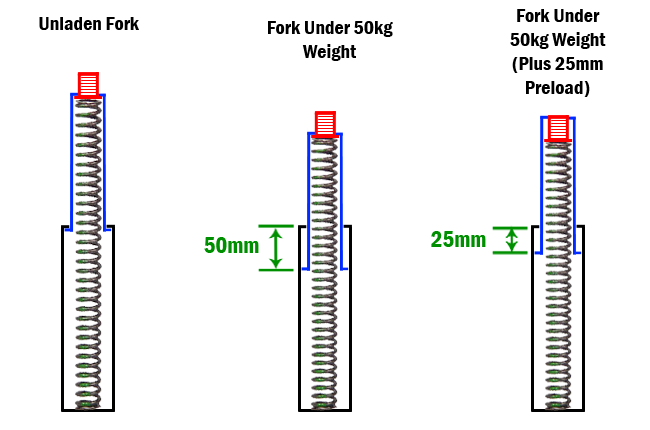Changing preload has no effect upon spring stiffness . It only changes the ride height by changing where the shock rests in it's travel.
Cut and pasted from:

 lifeatlean.com
lifeatlean.com
The Springs Don’t Compress With Preload
Ok that’s not strictly true. An unladen, fully extended fork (or shock) spring WILL compress when preload is added.
However, under yours and the bike’s weight, when preload is added the spring in the forks and shock do not compress. The spring remains the same length, but the forks and shock themselves actually extend.
Sounds confusing I know, but let me explain.
Imagine someone holding onto the rear of your bike, letting it rest upright under its own weight.
At that point in time, the springs will be compressed by a given amount based on the rate of the spring and how heavy the bike is.
When you wind on preload, the adjuster starts to push down on the spring and it tries to compress it, but in doing so you are changing the amount of force that the spring pushes straight back up (remember our earlier examples).
That then means that the spring needs MORE weight to be applied to it in order to compress it, thereby cancelling out a portion of the bike’s weight that was originally causing it to compress.
The spring’s length under the bike’s load doesn’t change, but now the fork (or shock) has actually extended.
More information

 www.motocd.com
www.motocd.com
cheers
ken
Cut and pasted from:

Teach Me Suspension (Part 3): Motorcycle Suspension Preload
Part 3 of our motorcycle suspension series takes a look at preload, what it does, and what happens to the bike when we make preload adjustments.
The Springs Don’t Compress With Preload
Ok that’s not strictly true. An unladen, fully extended fork (or shock) spring WILL compress when preload is added.
However, under yours and the bike’s weight, when preload is added the spring in the forks and shock do not compress. The spring remains the same length, but the forks and shock themselves actually extend.
Sounds confusing I know, but let me explain.
Imagine someone holding onto the rear of your bike, letting it rest upright under its own weight.
At that point in time, the springs will be compressed by a given amount based on the rate of the spring and how heavy the bike is.
When you wind on preload, the adjuster starts to push down on the spring and it tries to compress it, but in doing so you are changing the amount of force that the spring pushes straight back up (remember our earlier examples).
That then means that the spring needs MORE weight to be applied to it in order to compress it, thereby cancelling out a portion of the bike’s weight that was originally causing it to compress.
The spring’s length under the bike’s load doesn’t change, but now the fork (or shock) has actually extended.
More information

Motorcycle Rear Shock Adjustment | Cogent Dynamics | Motorcycle Suspension
Cogent Dynamics rear shocks are custom built for each customer and are delivered with settings which are excellent for most circumstances yet are designed with flexible adjustability.
 www.motocd.com
www.motocd.com
cheers
ken
Last edited:

